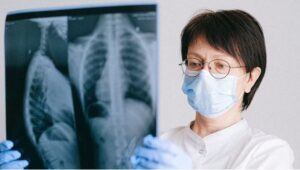Understanding Radiation Sterilization: A Key Method for Ensuring Product Safety and Longevity

To guarantee the safety and sterility of a variety of products, such as pharmaceuticals, food items, medical devices, and lab equipment, radiation sterilization is an essential procedure. By employing regulated dosages of ionizing radiation, this technique efficiently eradicates bacteria, germs, and other contaminants, rendering products safe for consumption and prolonging their shelf life. This article will discuss What Is Radiation Sterilization, its methods, the kinds of radiation that are utilized, as well as its advantages and disadvantages.
Radiation sterilization: What Is It?
High-energy radiation is used in the radiation sterilization process to eliminate microorganisms from products and surfaces, guaranteeing that they are free of dangerous infections. Even for objects that are sensitive to moisture or temperature, radiation sterilization works quite well in contrast to conventional sterilization techniques that employ heat, steam, or chemicals. It works especially well for sterilizing materials that are hard to get through, including complex medical equipment or thick plastic packaging.
Types of Radiation Used in Sterilization
Gamma rays, electron beams (E-beams), and X-rays are the three main forms of radiation that are utilized in sterilization. Every variety has unique qualities, advantages, and uses:
1. Radiation from Gamma Rays
Source: Isotopes of cobalt-60 or cesium-137
Procedure: In a facility that has been particularly developed, products are subjected to gamma rays.
Applications: Frequently utilized for food items, pharmaceuticals, and medical devices
Because of its capacity for deep penetration, gamma radiation is preferred for sterilizing large quantities of goods without the need for additional packaging or unpackaging.
2. Radiation from Electron Beams (E-beams)
Source: Machines that accelerate electrons
Procedure: A rapid, regulated dose of high-energy electrons is aimed at the product.
Applications: Frequently utilized in pharmaceuticals, medical disposables, and specific polymers
E-beam radiation is frequently used for products that require quick processing or can be sterilized in small quantities since it offers a speedy sterilization procedure that is usually finished in seconds.
3. Radiation from X-rays
Source: X-ray equipment with high energy
Procedure: In a dedicated chamber, products are exposed to X-rays.
Applications: In the food, medicinal, and environmental sectors
X-ray sterilization is appropriate for a range of applications, particularly for items needing high sterility assurance levels, because it combines the deep penetration of gamma radiation with the processing speed of E-beams.
Radiation sterilization applications
Many different businesses employ radiation sterilization, and each has its own sterility requirements and standards:
1. Medical Equipment and Supplies
To make sure they are free of impurities, medical items such as implants, syringes, catheters, and surgical instruments are frequently sterilized using radiation. For complicated devices with intricate designs that need deep penetration to achieve sterility, radiation is very advantageous.
2. Medicines
Certain medications and raw materials that are susceptible to heat and moisture are sterilized in the pharmaceutical business using radiation sterilization. It is crucial for medications that need to maintain their chemical stability and cannot tolerate traditional sterilizing techniques.
3. Agriculture and Food
In order to eradicate infections and increase shelf life without compromising nutritional value, radiation sterilization is being utilized more and more in food preservation. Additionally, by sterilizing agricultural products like grains, spices, and produce, it aids in stopping the spread of invasive species.
4. Research and Laboratory Equipment
Glassware, sensitive research instruments, and laboratory equipment are all sterilized using radiation. This removes microbial interference and guarantees proper research outcomes.
Advantages of Sterilization via Radiation
Compared to alternative techniques, radiation sterilization has the following benefits:
Non-Thermal Process: Since radiation sterilization doesn’t involve heat, it can be used on materials that are sensitive to heat.
High Efficiency: Quick and dependable, capable of quickly sterilizing individual objects or big batches.
Sterilizing intricate and tightly packed objects without disassembling them is possible with deep penetration.
Environmentally Friendly: Because radiation doesn’t leave behind harmful leftovers, handling and disposal are safer.
In conclusion
A strong and effective technique for guaranteeing the longevity and safety of a variety of products is radiation sterilization. It is essential in the food, pharmaceutical, and medical sectors due to its exceptional capacity to sterilize intricate and heat-sensitive objects. Radiation sterilization is anticipated to become even more efficient, economical, and popular as technology develops, establishing new benchmarks for hygienic practices and safety across a range of industries.
Radiation Sterilization FAQs
1. What Is Radiation Sterilization?
Radiation sterilization is a common practice that is acknowledged as safe and efficient for medical devices, particularly those that are heat-sensitive.
Q2. Is it possible for radiation to sterilize any kind of material?
Although radiation works well on a variety of materials, large radiation doses can cause some polymers and biological materials to break down or become brittle.
Q3. Are there any remnants from radiation sterilization?
No, radiation sterilization is safe for use in food and medicine because it doesn’t leave any harmful leftovers like other chemical sterilizing techniques do.
Q4. Does food get radiation sterilization?
Indeed, it is used to eradicate infections and prolong the shelf life of specific foods, and it has been licensed for usage in a number of nations by health authorities.
